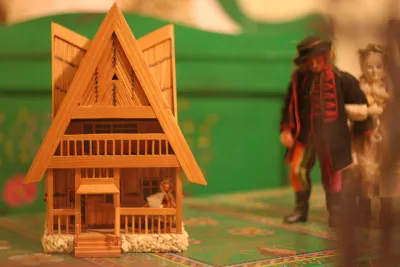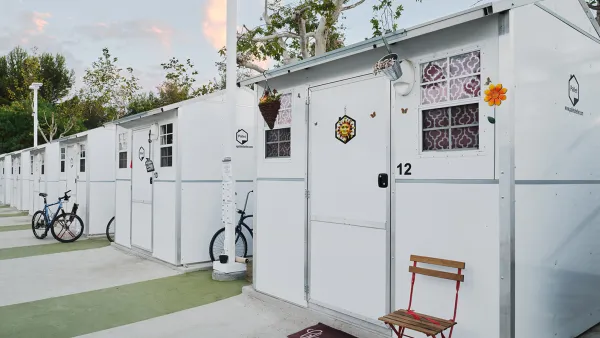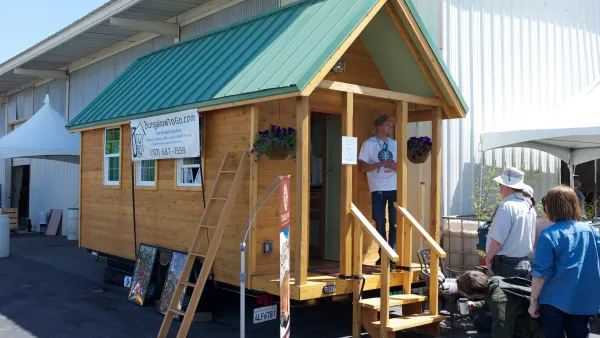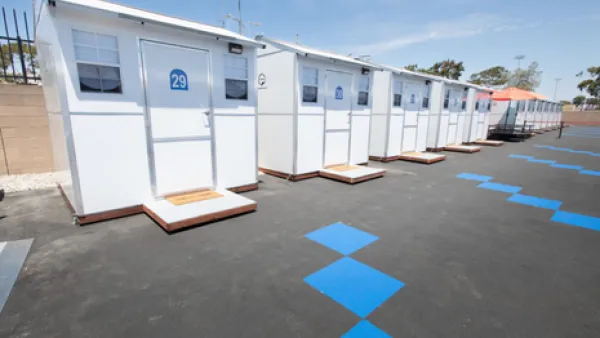Imagine if hosting a transitional tiny home village for the homeless became the norm for all suitable vacant land?

Last time I was in Atlanta, I stayed near a spot where dozens, probably hundreds, of homeless people would congregate on the sidewalks in a couple block radius around a center that served their needs. There we many things striking about this, but I remember one of the things that bothered me was the two large empty lots on the corner, which had signs on them expressly forbidding entrance or camping. One still had the foundation of a previous building, so though totally open to the sky, it still would have been a mildly sheltered and slightly more private place to be. Since the lots weren’t fenced off, and yet were empty, while the sidewalks were crowded, I had to assume that those signs were backed up by aggressive enforcement. Yuck.
Some folks in Denver are trying to do a little better. At the Intersections conference last month, the Urban Land Conservancy (ULC) and design group Radian, gave a brief presentation in the Ignite pitch session on the Beloved Community village. Beloved Community is a self-governed tiny home village for those transitioning out of homelessness, especially those not served by the shelter system. People with pets, couples, transgender folks, and people trying to stay sober, for example, can all find themselves either not welcome or not safe in shelters, and are therefore among the priorities for acceptance into the Beloved Community village. Various organizations provide supportive services to the residents, who share the work of maintaining the community.
ULC has some land that they will be building permanently affordable housing on—but that for now is sitting vacant while the predevelopment work happens. ULC director Aaron Miripol said that while ULC’s work aims to reduce the housing crisis over the long term by increasing affordable housing, there is also the very immediate question of what to do for people who are homeless now. As we’ve written about before, tiny home villages are one life-saving answer to that question. But they need somewhere to be.
FULL STORY: Tiny Homes for the Homeless—Would You Host a Village?

National Parks Layoffs Will Cause Communities to Lose Billions
Thousands of essential park workers were laid off this week, just before the busy spring break season.

Retro-silient?: America’s First “Eco-burb,” The Woodlands Turns 50
A master-planned community north of Houston offers lessons on green infrastructure and resilient design, but falls short of its founder’s lofty affordability and walkability goals.

Delivering for America Plan Will Downgrade Mail Service in at Least 49.5 Percent of Zip Codes
Republican and Democrat lawmakers criticize the plan for its disproportionate negative impact on rural communities.

Test News Post 1
This is a summary

Test News Headline 46
Test for the image on the front page.

Balancing Bombs and Butterflies: How the National Guard Protects a Rare Species
The National Guard at Fort Indiantown Gap uses GIS technology and land management strategies to balance military training with conservation efforts, ensuring the survival of the rare eastern regal fritillary butterfly.
Urban Design for Planners 1: Software Tools
This six-course series explores essential urban design concepts using open source software and equips planners with the tools they need to participate fully in the urban design process.
Planning for Universal Design
Learn the tools for implementing Universal Design in planning regulations.
EMC Planning Group, Inc.
Planetizen
Planetizen
Mpact (formerly Rail~Volution)
Great Falls Development Authority, Inc.
HUDs Office of Policy Development and Research
NYU Wagner Graduate School of Public Service





























